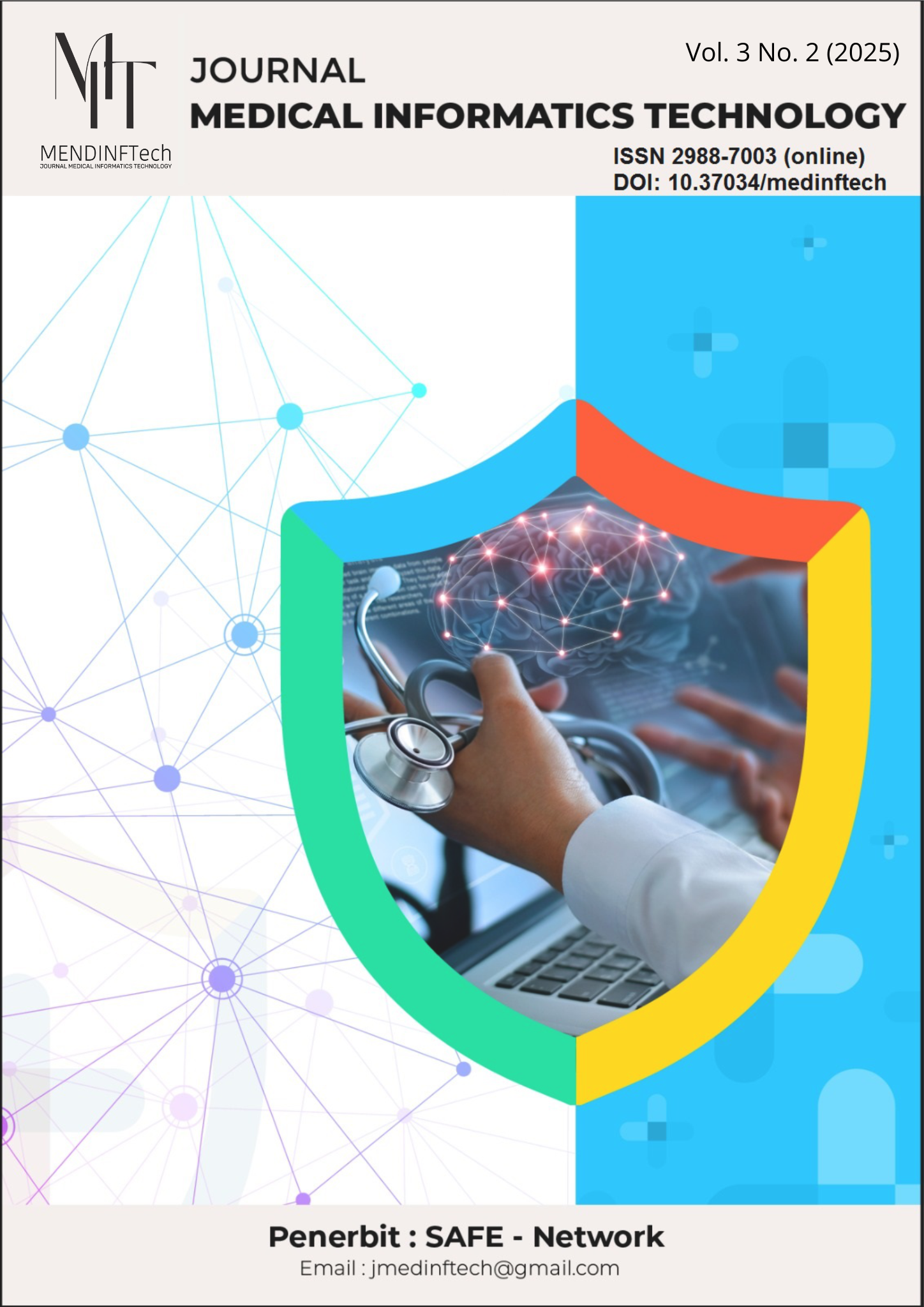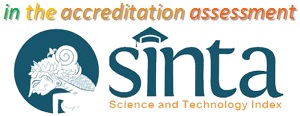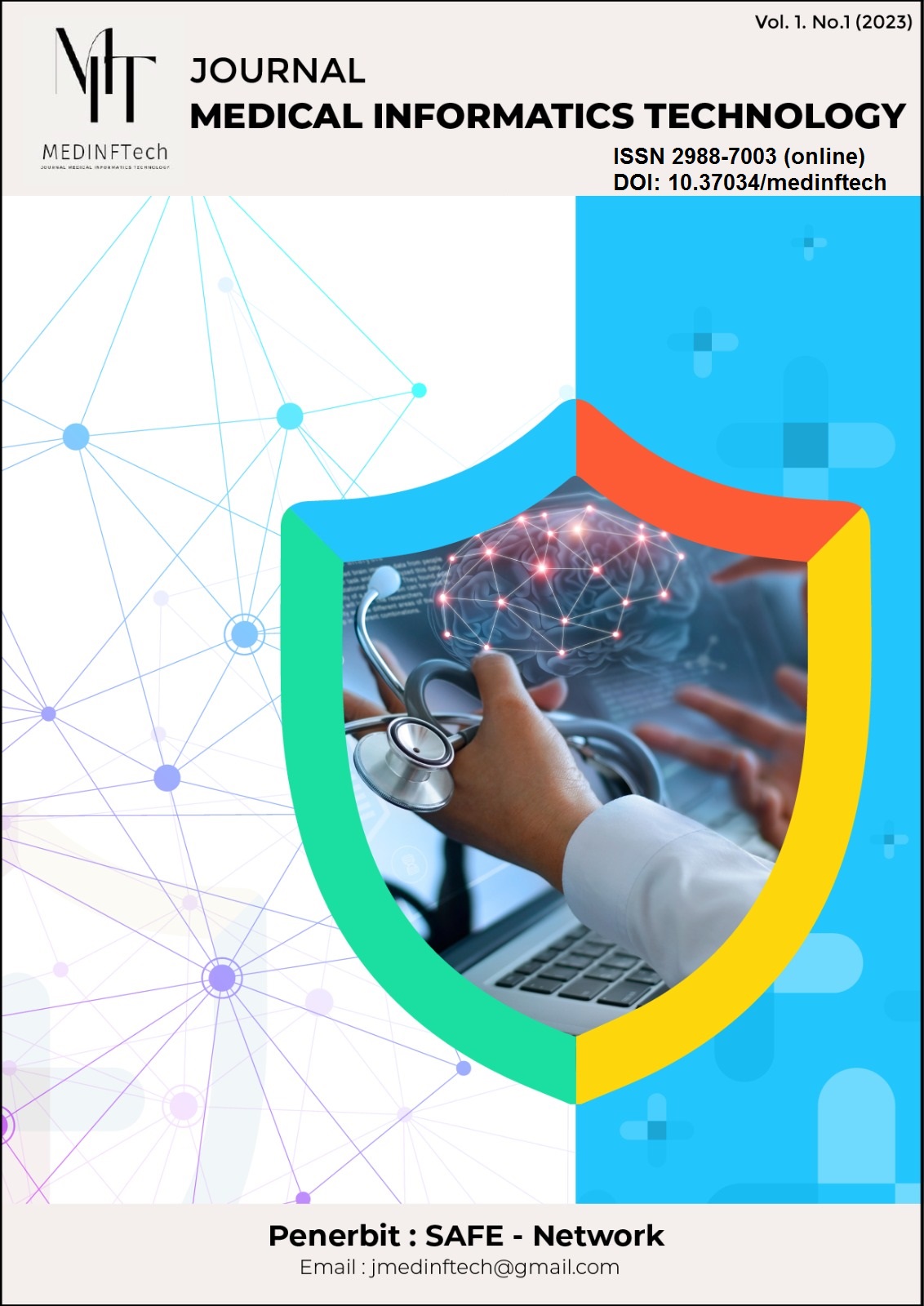Evaluating the Role of Data Modalities in Machine Learning Models for Psychiatric Disorder Diagnosis: A Review
DOI:
https://doi.org/10.37034/medinftech.v3i2.106Keywords:
Bipolar Disorder, Data Modalities, Depression, Machine Learning, Psychiatric DiagnosisAbstract
The increasing prevalence of psychiatric disorders such as depression, bipolar disorder, and post-traumatic stress disorder has drawn attention to the need for more efficient and accurate diagnostic tools. In this context, machine learning offers promising solutions by enabling the analysis of complex and high-dimensional data. This study aims to evaluate the diagnostic performance of ML models applied to various psychiatric disorders by comparing the effectiveness of different data types such as EEG, MRI, video and audio recordings, photographs, survey responses, and clinical data. A total of 44 scientific studies published between 2015 and 2024 were systematically reviewed in accordance with PRISMA 2020 guidelines. The studies included applied ML or deep learning models to adult participants. The results show that the most successful data types varied by disorder. In conclusion, the choice of data type significantly influences the performance of ML models in psychiatric diagnosis. EEG, survey, and clinical data emerged as the most reliable across different conditions, while SVM, Random Forest, and CNN-based models provided the best classification results. These findings offer a valuable reference point for future research and the development of AI-assisted diagnostic tools.
Downloads
References
A. M. Chekroud et al., “The promise of machine learning in predicting treatment outcomes in psychiatry,” World Psychiatry, vol. 20, no. 2, pp. 154–170, Jun. 2021, doi: 10.1002/wps.20882.
Z. S. Chen, P. (Param) Kulkarni, I. R. Galatzer-Levy, B. Bigio, C. Nasca, and Y. Zhang, “Modern views of machine learning for precision psychiatry,” Patterns, vol. 3, no. 11, p. 100602, Nov. 2022, doi: 10.1016/j.patter.2022.100602.
R. Iniesta, D. Stahl, and P. McGuffin, “Machine learning, statistical learning and the future of biological research in psychiatry,” Psychol. Med., vol. 46, no. 12, pp. 2455–2465, Feb. 2016, doi: 10.1017/S0033291716001367.
World Health Organization (WHO), “Mental disorders,” 2022. https://www.who.int/news-room/fact-sheets/detail/mental-disorders (accessed Mar. 21, 2025).
D. Bzdok and A. Meyer-Lindenberg, “Machine Learning for Precision Psychiatry: Opportunities and Challenges,” Biological Psychiatry: Cognitive Neuroscience and Neuroimaging, vol. 3, no. 3. Elsevier, pp. 223–230, Mar. 01, 2018, doi: 10.1016/j.bpsc.2017.11.007.
A. Singh and D. Kumar, “Identification of Anxiety and Depression Using DASS-21 Questionnaire and Machine Learning,” in Proceedings of the 1st International Conference on Advances in Computing and Future Communication Technologies, ICACFCT 2021, 2021, pp. 69–74, doi: 10.1109/ICACFCT53978.2021.9837365.
S. A. Nimsarkar and R. B. Ingle, “NayaN: A Multi-View Neural Network Approach to Detect Depression,” 5th IEEE Int. Conf. Artif. Intell. Eng. Technol. IICAIET 2023, pp. 262–267, 2023, doi: 10.1109/IICAIET59451.2023.10292046.
N. B. Ogur, C. Ceken, Y. S. Ogur, H. U. Yuvaci, A. B. Yazici, and E. Yazici, “Development of an Artificial Intelligence-Supported Hybrid Data Management Platform for Monitoring Depression and Anxiety Symptoms in the Perinatal Period: Pilot-Scale Study,” IEEE Access, vol. 11, pp. 31456–31466, 2023, doi: 10.1109/ACCESS.2023.3262467.
Z. Jiang et al., “Classification of Depression Using Machine Learning Methods Based on Eye Movement Variance Entropy,” IEEE Access, 2024, doi: 10.1109/ACCESS.2024.3451728.
S. Colic, D. J. Richardson, P. James Reilly, and M. Gary Hasey, “Using Machine Learning Algorithms to Enhance the Management of Suicide Ideation,” in Proceedings of the Annual International Conference of the IEEE Engineering in Medicine and Biology Society, EMBS, Oct. 2018, vol. 2018-July, pp. 4936–4939, doi: 10.1109/EMBC.2018.8513200.
Q. Wang and N. Liu, “Speech Detection of Depression Based on Multi-mlp,” in Proceedings - 2022 IEEE International Conference on Bioinformatics and Biomedicine, BIBM 2022, 2022, pp. 3896–3898, doi: 10.1109/BIBM55620.2022.9995447.
Y. Shen, H. Yang, and L. Lin, “Automatic Depression Detection: An Emotional Audio-Textual Corpus And A Gru/Bilstm-Based Model,” in ICASSP, IEEE International Conference on Acoustics, Speech and Signal Processing - Proceedings, 2022, vol. 2022-May, pp. 6247–6251, doi: 10.1109/ICASSP43922.2022.9746569.
A. Zaman, S. S. Ferdous, N. Akhter, T. I. Ena, M. M. Nabi, and S. A. Asma, “A Multilevel Depression Detection from Twitter using Fine-Tuned RoBERTa,” in 2023 International Conference on Information and Communication Technology for Sustainable Development, ICICT4SD 2023 - Proceedings, 2023, pp. 280–284, doi: 10.1109/ICICT4SD59951.2023.10303632.
S. Prabhudesai, M. Parmar, A. Mhaske, and S. Bhagwat, “Depression detection and analysis using deep learning: Study and comparative analysis,” in Proceedings - 2021 IEEE 10th International Conference on Communication Systems and Network Technologies, CSNT 2021, 2021, pp. 570–574, doi: 10.1109/CSNT51715.2021.9509707.
M. Patil and V. Wadhai, “Selection of Classifiers for Depression Detection Using Acoustic Features,” 2021, doi: 10.1109/ICCICA52458.2021.9697240.
L. Minkowski, K. V. Mai, and D. Gurve, “Feature Extraction to Identify Depression and Anxiety Based on EEG,” in Proceedings of the Annual International Conference of the IEEE Engineering in Medicine and Biology Society, EMBS, 2021, pp. 6322–6325, doi: 10.1109/EMBC46164.2021.9630821.
F. Chen et al., “Different Sub-bands Assessment of the Resting-state Prefrontal EEG in Depression Patients,” 2022, doi: 10.1109/ICSMD57530.2022.10058461.
N. Sakib, M. K. Islam, and T. Faruk, “Machine Learning Based Depression Screening Among Young Adults Using Wireless EEG,” in 2023 International Conference on Artificial Intelligence Innovation, ICAII 2023, 2023, pp. 110–115, doi: 10.1109/ICAII59460.2023.10497265.
M. Kang, S. H. Oh, K. S. Oh, S. Kang, and Y. Lee, “The deep learning method for predict beck’s depression inventory score using EEG,” in International Conference on ICT Convergence, 2021, vol. 2021-Octob, pp. 490–493, doi: 10.1109/ICTC52510.2021.9620922.
M. Yang, C. Cai, and B. Hu, “Clustering Based on Eye Tracking Data for Depression Recognition,” IEEE Trans. Cogn. Dev. Syst., vol. 15, no. 4, pp. 1754–1764, Dec. 2023, doi: 10.1109/TCDS.2022.3223128.
T.-F. Ma et al., “Detecting Major Depression Disorder with Multiview Eye Movement Features in a Novel Oil Painting Paradigm,” in 2024 International Joint Conference on Neural Networks (IJCNN), Sep. 2024, pp. 1–8, doi: 10.1109/ijcnn60899.2024.10650558.
A. Routray, A. Mishra, M. Sahoo, S. Mohapatra, and S. Mohapatra, “Detecting Depression: A Holistic Approach through Questionnaires with Facial Expression Recognition,” in 2024 15th International Conference on Computing Communication and Networking Technologies (ICCCNT), Jun. 2024, pp. 1–6, doi: 10.1109/ICCCNT61001.2024.10724001.
S. Nasim et al., “Novel Meta Learning Approach for Detecting Postpartum Depression Disorder Using Questionnaire Data,” IEEE Access, vol. 12, pp. 101247–101259, 2024, doi: 10.1109/ACCESS.2024.3427685.
R. Jadhav, V. Chellwani, S. Deshmukh, and H. Sachdev, “Mental disorder detection: Bbipolar disorder scrutinization using machine learning,” in Proceedings of the 9th International Conference On Cloud Computing, Data Science and Engineering, Confluence 2019, Jan. 2019, pp. 304–308, doi: 10.1109/CONFLUENCE.2019.8776913.
N. Agnihotri and S. K. Prasad, “Predicting the Symptoms of Bipolar Disorder in Patients using Machine Learning,” in Proceedings of the 2021 10th International Conference on System Modeling and Advancement in Research Trends, SMART 2021, 2021, pp. 697–702, doi: 10.1109/SMART52563.2021.9676247.
R. Borges, R. Salvini, A. A. Nierenberg, G. S. Sachs, B. Lafer, and R. S. Dias, “Forecasting depressive relapse in Bipolar Disorder from clinical data,” in Proceedings - 2018 IEEE International Conference on Bioinformatics and Biomedicine, BIBM 2018, Jan. 2018, pp. 613–616, doi: 10.1109/BIBM.2018.8621255.
D. N. Disha, S. Seema, C. S. Soumya, S. Rao, and Rakshitha, “Predictive Modelling of Bipolar Disorder Utilizing Advanced Machine Learning Techniques,” 2023, doi: 10.1109/INCOFT60753.2023.10425438.
D. N. Disha, S. Seema, S. U. Shenoy, and S. Rao, “Prediction of Bipolar Disorder Using Machine Learning Techniques,” 2022, doi: 10.1109/CONIT55038.2022.9848137.
D. Fitriati, F. Maspiyanti, and F. A. Devianty, “Early detection application of bipolar disorders using backpropagation algorithm,” in International Conference on Electrical Engineering, Computer Science and Informatics (EECSI), 2019, pp. 40–44, doi: 10.23919/EECSI48112.2019.8977102.
S. A. Thamrin and A. L. P. Chen, “Detection of Bipolar Disorder on Social Media Data Utilizing Biomedical, Clinical and Mental Health Domain Fine-Tuned Word Embeddings,” in Proceedings - 2024 IEEE 12th International Conference on Healthcare Informatics, ICHI 2024, 2024, pp. 612–619, doi: 10.1109/ICHI61247.2024.00098.
O. Cigdem et al., “Classification of healthy siblings of bipolar disorder patients from healthy controls using MRI,” in TIPTEKNO 2019 - Tip Teknolojileri Kongresi, Oct. 2019, pp. 1–4, doi: 10.1109/TIPTEKNO.2019.8895015.
E. Kadkhoda, M. Khorasani, F. Pourgholamali, M. Kahani, and A. R. Ardani, “Bipolar disorder detection over social media,” Informatics Med. Unlocked, vol. 32, Jan. 2022, doi: 10.1016/j.imu.2022.101042.
S. A. Farooq, A. M. Wani, and S. Rafiq, “Post-traumatic stress disorder (PTSD) prediction in Covid-19 survivors- A Clinical Questionnaire and Machine Learning Based Approach,” 2022, doi: 10.1109/NKCon56289.2022.10126735.
K. Nagarajaiah, M. H. Krishnappa, and K. R. Asha, “Machine Learning based Detection of Post Traumatic Stress Disorder of Mental Health,” in 2023 4th International Conference on Electronics and Sustainable Communication Systems, ICESC 2023 - Proceedings, 2023, pp. 1456–1460, doi: 10.1109/ICESC57686.2023.10193036.
M. A. Ul Alam and D. Kapadia, “LAXARY: A Trustworthy Explainable Twitter Analysis Model for Post-Traumatic Stress Disorder Assessment,” in Proceedings - 2020 IEEE International Conference on Smart Computing, SMARTCOMP 2020, Sep. 2020, pp. 308–313, doi: 10.1109/SMARTCOMP50058.2020.00069.
J. A. Cruz, J. C. Marquez, A. M. Mendoza, J. I. Reyes, V. C. Tango, and S. V. Prado, “EEG-based Characterization and Classification of Severity for the Diagnosis of Post-Traumatic Stress Disorder (PTSD),” 2023, doi: 10.1109/BioSMART58455.2023.10162084.
T. Yamunarani et al., “Analysis of Post-Traumatic Stress Disorder (PTSD) Using Electroencephalography,” in 2024 15th International Conference on Computing Communication and Networking Technologies (ICCCNT), Jun. 2024, pp. 1–6, doi: 10.1109/ICCCNT61001.2024.10724154.
S. I. Omurca and E. Ekinci, “An alternative evaluation of post traumatic stress disorder with machine learning methods,” Sep. 2015, doi: 10.1109/INISTA.2015.7276754.
M. Shim, S. H. Lee, and H. J. Hwang, “Altered cortical activation and functional network in post-traumatic stress disorder (PTSD) during an auditory cognitive processing,” Feb. 2020, doi: 10.1109/BCI48061.2020.9061661.
H. Jahrami et al., “How accurately can supervised machine learning model predict a targeted psychiatric disorder?,” BMC Psychiatry, vol. 24, no. 1, Dec. 2024, doi: 10.1186/s12888-024-06152-w.
M. Uluyagmur-Ozturk et al., “ADHD and ASD Classification Based on Emotion Recognition Data,” in 2016 15th IEEE International Conference on Machine Learning and Applications (ICMLA), Dec. 2016, pp. 810–813, doi: 10.1109/ICMLA.2016.0145.
I. Elujide, S. G. Fashoto, B. Fashoto, E. Mbunge, S. O. Folorunso, and J. O. Olamijuwon, “Application of deep and machine learning techniques for multi-label classification performance on psychotic disorder diseases,” Informatics Med. Unlocked, vol. 23, Jan. 2021, doi: 10.1016/j.imu.2021.100545.
M. Srividya, S. Mohanavalli, and N. Bhalaji, “Behavioral Modeling for Mental Health using Machine Learning Algorithms,” J. Med. Syst., vol. 42, no. 5, May 2018, doi: 10.1007/s10916-018-0934-5.
C. Wanderley Espinola, J. C. Gomes, J. Mônica Silva Pereira, and W. P. dos Santos, “Detection of major depressive disorder, bipolar disorder, schizophrenia and generalized anxiety disorder using vocal acoustic analysis and machine learning: an exploratory study,” Res. Biomed. Eng., vol. 38, no. 3, pp. 813–829, Sep. 2022, doi: 10.1007/s42600-022-00222-2.
M. Margarette Sanchez et al., “A Machine Learning Algorithm to Discriminating Between Bipolar and Major Depressive Disorders Based on Resting EEG Data,” in Proceedings of the Annual International Conference of the IEEE Engineering in Medicine and Biology Society, EMBS, 2022, vol. 2022-July, pp. 2635–2638, doi: 10.1109/EMBC48229.2022.9871453.
K. Zhao and H.-C. So, “Drug Repositioning for Schizophrenia and Depression/Anxiety Disorders: A Machine Learning Approach Leveraging Expression Data,” IEEE J. Biomed. Heal. Informatics, vol. 23, no. 3, pp. 1304–1315, 2019, doi: 10.1109/JBHI.2018.2856535.
G. A. J. Masengi, T. Sardjono, and M. H. Purnomo, “Investigating Deep Learning for Classification of Psychiatric Disorders on Brain MRI Data Using GAN-Based Augmentation,” in 2023 International Conference on Electrical and Information Technology (IEIT), Sep. 2023, pp. 231–236, doi: 10.1109/IEIT59852.2023.10335528.
J. Verma, D. K. Singh, A. Tyagi, P. K. Ram, S. Singh, and S. Ratna, “Classification of Psychiatric Disorders Using QEEG Data Through Convolution Neural Networks and Gated Recurrent Units,” in Proceedings of International Conference on Communication, Computer Sciences and Engineering, IC3SE 2024, 2024, pp. 961–967, doi: 10.1109/IC3SE62002.2024.10593583.
P. J. Alphonsa Sini and K. K. Sherly, “Early Detection of Anxiety, Depression and Stress among Potential Patients using machine learning and deep learning models,” 2023, doi: 10.1109/ICCSC56913.2023.10143026.









